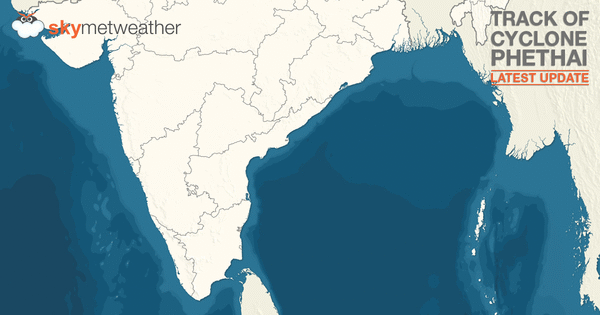 With Cyclone Phethai nearing, Andhra Pradesh is gearing up for heavy to very heavy rains for the next two days. The Cyclonic Strom Phethai over Southwest Bay of Bengal has been constantly gaining more strength and is presently centered near latitude 11.3°N and longitude 84.4°E, about 465 km east-northeast of Trincomalee, Sri Lanka, 480 km east-southeast of Chennai, Tamil Nadu, 640 km south-southeast of Machilipatnam, Andhra Pradesh and 670 km south-southeast Kakinada, Andhra Pradesh.
With Cyclone Phethai nearing, Andhra Pradesh is gearing up for heavy to very heavy rains for the next two days. The Cyclonic Strom Phethai over Southwest Bay of Bengal has been constantly gaining more strength and is presently centered near latitude 11.3°N and longitude 84.4°E, about 465 km east-northeast of Trincomalee, Sri Lanka, 480 km east-southeast of Chennai, Tamil Nadu, 640 km south-southeast of Machilipatnam, Andhra Pradesh and 670 km south-southeast Kakinada, Andhra Pradesh.
It might also intensify into a severe cyclonic storm but that would be for very short duration. And it is most likely to hit the coast as a tropical storm only.
 Moving in north-northwest direction, Phethai is all set to make landfall over the coast of Andhra Pradesh by December 17 afternoon between Machilipatnam and Kakinada. As per the weathermen, the cloud configuration is indicating that the peripherals of the system are already reaching the coast.
Moving in north-northwest direction, Phethai is all set to make landfall over the coast of Andhra Pradesh by December 17 afternoon between Machilipatnam and Kakinada. As per the weathermen, the cloud configuration is indicating that the peripherals of the system are already reaching the coast.
Must Watch: Cloud build up of Cyclone Phethai in less than 30 seconds
With this, clouding would now increase over coastal areas of Tamil Nadu, Andhra Pradesh and Odisha. Rains are also likely to commence soon. We are expecting heavy to very heavy rains along the Coastal Andhra Pradesh for the next two days. Kakinada, Machilipatnam, Ongole, Kavali are expected to record heavy to very heavy rains on December 16 and 17. At the time of landfall, we can expect some isolated spells of extremely heavy rains on Monday.
These torrential rains would be accompanied with squally winds of 90-100 kmph gusting upto 110 kmph. In fact, at present also, high velocity winds to the tune of 70-80 kmph can be witnessed along the coast.
Sea conditions have already become rough to very rough off and along the coast and we strongly advise fishermen and locals not venture out in the sea. At the time of landfall, storm surge of height of around 50 cm to 1 m are likely that may inundate low lying areas of Coastal Andhra Pradesh, particularly East and West Godavari, Vishakhapatnam, Krishna and Guntur Districts.
Image Credit:en.wikipedia.org
Any information taken from here should be credited to skymetweather.com




